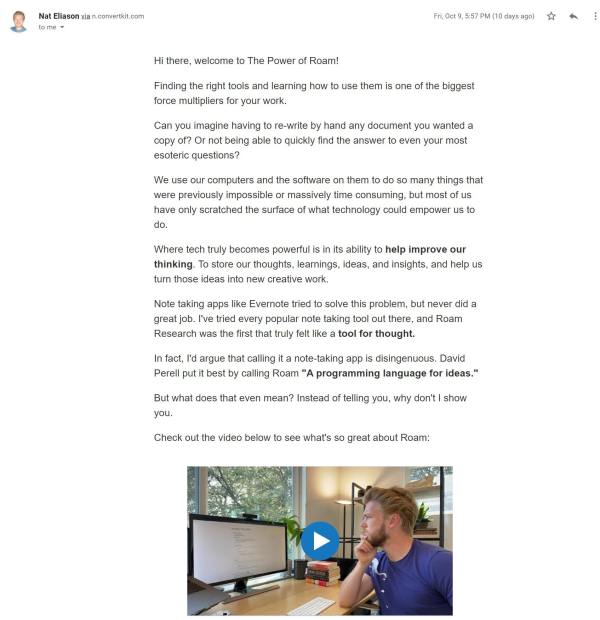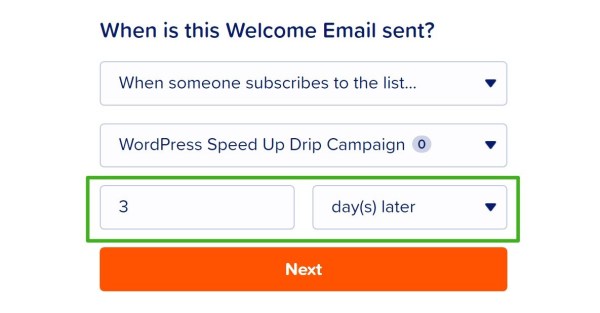If you want to get the most from your email marketing efforts, it’s important to go beyond one-off email blasts and create some type of automated sequence to build relationships with your subscribers and move them to action.
How can you do that? With an email drip campaign.
Drip campaigns let you “drip” out emails over time. Unlike a one-off blast, this lets you create a cohesive series of emails that are all structured around achieving a specific goal.
In this post, we’ll help you learn how to harness this strategy for your own efforts. We’ll explain more about what drip campaigns are and give you an example of what one might look like.
Then, we’ll share some best practices and show you how to create your own email drip campaigns using MailPoet.
What is an email drip campaign?
In a nutshell, a drip campaign is a sequence of emails that you send to a user based on a specific timeline or specific actions of a user (like whether or not they opened the previous email).
Instead of sending the user all the information at one time, you “drip” the content out over time. This helps you build a relationship because you’re constantly connecting with each user. This is why people typically call this “nurturing” your subscriber.
You’ll also see drip campaigns called other names like autoresponders, lifecycle emails, automated emails, etc. It’s the same basic idea with all those terms.
The important thing about drip campaigns is that they’re unique to each user. That is, the “schedule” of the campaign is set for each individual user, not globally for your entire list. Typically, you’ll use the date that a person joined your email list as the “kick off” for their drip campaign.
An illustrative example of a drip campaign
To drive home what drip campaigns are, let’s look at one of the most common examples of a drip campaign – a series of welcome emails that a user receives after signing up.
Let’s say you sell a premium course that teaches people to speed up WordPress. If you just ask people to sign up for your course right away in the welcome email, your conversion rate probably won’t be very high because people don’t know who you are and they might not even know why speed is important.
Instead, you decide to set up a drip campaign with the goal of eventually moving people to purchase your course. It might look something like this:
- Day 1: Welcome email that sets the stage and explains what types of emails you’re going to be sending.
- Day 3: An email that shares data on why it’s so important to have a quick-loading site.
- Day 6: An email that explains the biggest reasons why most WordPress sites load slowly.
- Day 9: An email that encourages people that they don’t need to be a developer to speed up WordPress.
- Day 12: An email with a CTA to sign up for your WordPress speed-up course.
By sending out this drip campaign, you would’ve:
- Built a relationship with the subscriber – you’re no longer a stranger.
- Educated the subscriber on why they really need to care about site speed.
- Shown them that their site probably has a lot of problems…but that they don’t need to feel overwhelmed because they can fix them without the help of a developer.
All of those things make it more likely for the person to purchase your course on “Day 12”, which is why drip marketing is such a powerful tactic.
Five best practices for creating drip campaigns
Now that you know why drip campaigns are important, let’s start pivoting into the actionable part of this post by talking about some best practices to follow when setting up drip campaigns.
1. Properly set expectations on the signup form
Creating an effective drip campaign starts with setting expectations on your signup form. You should tell them what types of emails you’re going to send them and how often subscribers will receive emails.
For example, if you’re going to send people seven emails over seven days, you should tell people that. This accomplishes two things:
- It lets people know that you’re not just going to spam them. If people start receiving a daily email from you without any context, they might get annoyed. But if they knew that when they signed up, they wouldn’t be.
- It lets people know to expect your emails every X days, which will boost your open rates.
For example, in a CTA for one of our own drip campaigns, we tell visitors to expect a “4-part email course”.

2. Make sure your emails tie together
A good drip campaign shouldn’t feel like a bunch of random emails strung together, it should be a cohesive sequence where each email builds on the others.
One trick that can help you do this is to write all of the emails in one sitting (or at least the first drafts!). That way, you can guarantee that everything flows together. If you try to write them at separate times, it’s easy to slip into having them sound disjointed.
3. Don’t be afraid to get personal
One of the big goals of drip marketing is to build a connection and “nurture” your subscribers. It’s not some one-off sales email announcing your Black Friday promotions, it’s a series of emails that all build on each other to drive action.
So – don’t be afraid to get personal. Many of the best drip campaigns start off with a simple, but personal, introduction email. Show them the person behind the website and start building that connection.
For example, check out this introduction email in a drip sequence on Roam Research from Nat Eliason – it’s quite personal and almost feels like a conversation:

4. Get the timing right
A large part of setting up your drip campaign is controlling the timing. That is, when the individual emails in your drip campaign will be sent to each person.
If you send them too often, you might annoy people (though properly setting expectations can limit this). If you wait too long to send them, people might forget about you, which will depress your open rates.
If you’re not sure where to start, sending emails every 3-4 days is a good balance.
5. Keep following all the general email marketing best practices
Finally, remember that drip campaigns are still emails, which means that you’ll also want to follow all of the general email best practices when it comes to writing subject lines, body text, etc.
Here, we have a lot of guides that can help you out:
- Tips for improving your email subject lines
- Examples of excellent email subject lines
- Why you should keep your emails short
- Best practices for including links in emails
How to set up your first email drip campaign in MailPoet
Ready to get started with your first email drip campaign? MailPoet lets you start sending these types of automated campaigns without leaving your WordPress dashboard.
Here’s how to get up and running in no time…
1. Set up MailPoet
If you’re already using MailPoet, you can skip to the next step to start setting up your drip campaign. But if you haven’t installed the MailPoet plugin yet, you’ll need to get that done before you can start sending emails.
The MailPoet plugin is available for free at WordPress.org – you can install it by going to Plugins → Add New and searching for “MailPoet”.
From there, you can follow the prompts to set everything up. Or, check out the getting started guide for a little helping hand. We recommend using the MailPoet sending service so that you can be sure your drip campaigns make it to people’s inboxes (and not the dreaded spam folder).
As part of the setup process, you might want to create a dedicated form and list for your drip campaign – it’s totally up to you. You could also just send the drip campaign to all your new subscribers if you want to keep things simple.
2. Set up a new welcome email
MailPoet lets you send a few different types of emails. For a drip campaign, you want to set up a welcome email, which is what lets you send an email based on when each individual person signs up to a specific list.
You can set up multiple welcome emails at different times, which is how you’ll build your drip campaign.
For now, though, let’s focus on the first email.
To get started, go to the MailPoet tab and click Add New to create a new email. Then, find the Welcome Email option and click either Set up or Create (depending on whether you’ve already created a welcome email or not).

Then, you can choose:
- When to trigger the email – typically, you’ll want to do this when someone joins a list, but you could also base it on when they register for your WordPress site (which is great for eCommerce stores, membership sites, online courses, etc.).
- Which list to send to – if you created a separate list for your drip campaign, you’ll want to select that here.
- When to send the email – for this first email, you’re creating the actual welcome email, so you probably want to leave it as “immediately”. In the next section, you’ll change this when creating the other emails in your drip campaign.

Next, you can choose one of MailPoet’s pre-made templates. Or, you also might want to go with a simple text email, which can be an effective tactic for drip campaigns (especially if you’re communicating as an individual, rather than a business):

Next, you can add content and design your email using MailPoet’s visual drag-and-drop editor. Remember – there’s no need to start selling right away. For this first email, you’re just trying to build a connection:

On the last page, you’ll be able to configure the sender/reply-to and you’ll also see a summary of some of the choices you made earlier. To make your first email live, click Activate:

3. Repeat the process as many times as needed
Now, you just need to repeat the same process for additional emails in your drip campaign.
The only difference is that you’ll choose different times to send each email. For example, let’s say you want to send the second email in your campaign three days after the welcome email.
All you need to do is change the drop-down from “immediately” to “3 days later”:

If you want to have the next email go out three days after that, you would create another email and set it equal to “6 days later”:

The important thing to remember here is that all the timing refers to when someone signed up to your list, not when the most recent email was sent. So when you set up your timing, just make sure to make all the timing relative to the signup date.
And that’s it! Once you’ve created all of your emails, you’ll see them all in the Welcome Emails tab. You can also quickly see how everything connects by looking at the Settings column:

Once you start sending out your drip campaign, you’ll be able to see stats on clicks and opens, which will let you adjust the emails as needed to optimize any weak points.
Create your first email drip marketing campaign today
Learning how to effectively use drip campaigns is an important part of any email marketing strategy.
Drip campaigns help you build relationships and “nurture” your subscribers, which increases the chances that your subscribers will perform whatever action you want them to perform.
With MailPoet, you can start creating drip campaigns without leaving your WordPress dashboard – all you need to do is install the MailPoet plugin and start creating welcome emails.
Do you still have any questions about how to create your first drip campaign? Ask us in the comments section!




I have now set up a drip campaign which is triggered when a user signs up to my newsletter mailing list. I would like to offer this course also to existing subscribers. How can I do that? Thanks :)